The Nexus 7 (2013) Review
by Anand Lal Shimpi on August 22, 2013 6:00 PM EST
Truth be told, Google has made (or at least directed the making of) some of the best tablets on the market today. The original Nexus 7 was groundbreaking in that it offered a totally usable platform, married to the latest version of Android, for $199. The Nexus 10 gave us a very quick, ultra high resolution 10-inch tablet for $100 less than the flagship iPad (and with more storage). Both were easily recommendable due to their value, but this year Google is stepping out of the shadow of value and into one of excellence. It starts with the new Nexus 7.
Based on the success of the original Nexus 7, Google went back to ASUS for the second version. In the 12 months since the release of the Nexus 7, the world has changed quite a bit. Expectations for value tablets had been reset by the original Nexus 7 as well as Amazon's lineup of Kindle Fires. Simply showing up with another good value likely wouldn't do anything to further the brand (or market). I get the distinct impression that Google isn't big on not changing the world.
| Nexus 7 Tablet Specification Comparison | ||||
| ASUS Nexus 7 (2012) | ASUS Nexus 7 (2013) | |||
| Dimensions | 198.5 x 120 x 10.45mm | 200 x 114 x 8.65mm | ||
| Chassis | Plastic + Rubber back | Plastic + Soft Touch back | ||
| Display | 7-inch 1280x800 IPS | 7.02-inch 1920x1200 IPS | ||
| Weight | 340 g | 290 grams (WiFi), 299 grams (LTE) | ||
| Processor | 1.3 GHz NVIDIA Tegra 3 (T30L - 4 x Cortex A9) | 1.5 GHz Qualcomm Snapdragon S4 Pro (APQ8064-1AA) | ||
| Memory | 1 GB | 2 GB DDR3L | ||
| Storage | 8 GB / 16 GB | 16 GB / 32 GB | ||
| Battery | 16 Whr | 15.01 Whr | ||
| WiFi/Connectivity | 802.11b/g/n, BT, NFC | 802.11a/b/g/n, BT 4.0, NFC | ||
| Camera | 1.2MP Front Facing |
5.0 MP Rear Facing w/AF 1.2MP Front Facing |
||
| Wireless Charging | – | Yes (Qi Compatible) | ||
| Pricing | $199/$249 |
$229/$269 (WiFi 16/32 GB) $349 (LTE) |
||
The result is the new Nexus 7. Identical only in name, manufacturer and screen size, the 2013 Nexus 7 is a downright Apple way to rev a product. Google made it thinner, lighter, faster and better in almost every way.

2013 Nexus 7 (left) vs. 2012 Nexus 7 (right)
The original Nexus 7 was rather thick but it got away with it since the overall footprint of the tablet was so small. The new Nexus 7 truly feels like a slate. It's the type of thing I expect to see carried around on the Enterprise.
I don't miss the rubber imitation leather from the original Nexus 7, it's replaced by a soft touch plastic back. You definitely don't get the premium aluminum feel of the iPad mini, but the device doesn't feel cheap either. The new Nexus 7 is still nice enough that I'm nervous about scratching or scuffing the back.
Both ASUS and Nexus logos are prominently featured on the back. ASUS continues to amaze me by just how far it's come as a company, and the new Nexus 7 is hands down its most impressive tablet creation yet. From a build quality standpoint I really have no complaints about the Nexus 7. While the MeMO Pad HD7 has some creaks and flex in the chassis, the new Nexus 7 feels like a solid slab of soft plastic and glass. It's nice.
Unlike the original Nexus 7, the new model features stereo speakers on back of the tablet. It's an easy feature to take for granted but going back to the old mono design sounds worse.
I agree with Brian that the power/lock and volume buttons are the only real sore spot on the physical execution. They aren't particularly well defined and feel a bit mushy. Even writing this paragraph feels like I'm nit picking though, the build here is really good.
The only other complaint I'd levy against the new Nexus 7 is that the design doesn't particularly stand out as being unique. The iPad has its aluminum, the Moto X has its wood, but the Nexus 7 falls victim to the fact that ultimately it's tough to make these ultra mobile devices stand out. You need a large glass surface and you need a back. Black also tends to be one of the easier colors to sell (get too creative and you end up with inventory problems). It's not a huge deal to me personally, but as mobile devices can often be fashion statements I don't know that the new Nexus 7 has all that much curb appeal.
The Display
What the Nexus 7 lacks in pizazz, it completely makes up for once you power on the display. The 7-inch 1920 x 1200 display produces colors that are not only vibrant but, for the first time ever in a Nexus device, accurate as well. Google really worked on color accuracy this time, with a two step calibration process - once at a high level by the panel maker and once again per device during final manufacturing. The result is just awesome:
The Nexus 7 display is not only visually appealing but stacks up incredibly well in our CalMAN display tests. Although it loses to the iPad 4, the Nexus 7 gets indiscernibly close in many cases and blows the non-Retina iPad mini out of the water. I won't even bother comparing it to everything else in the Android space, they don't hold a candle to it.
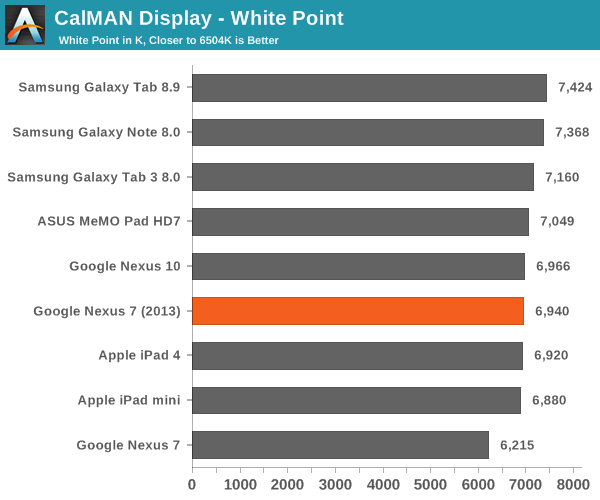
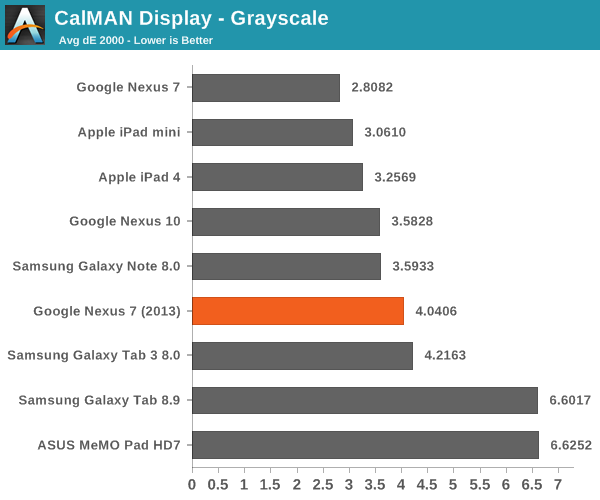
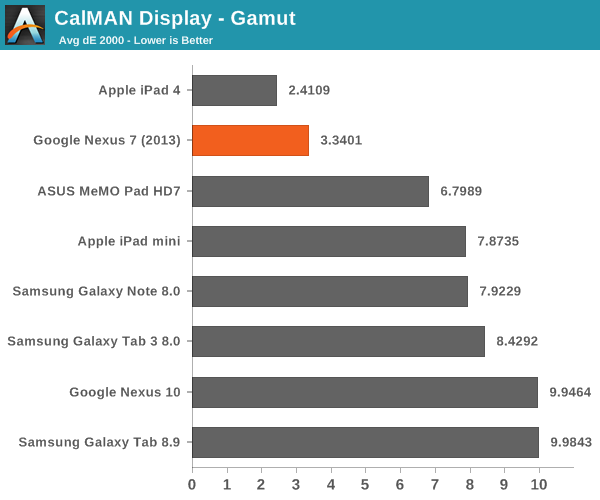
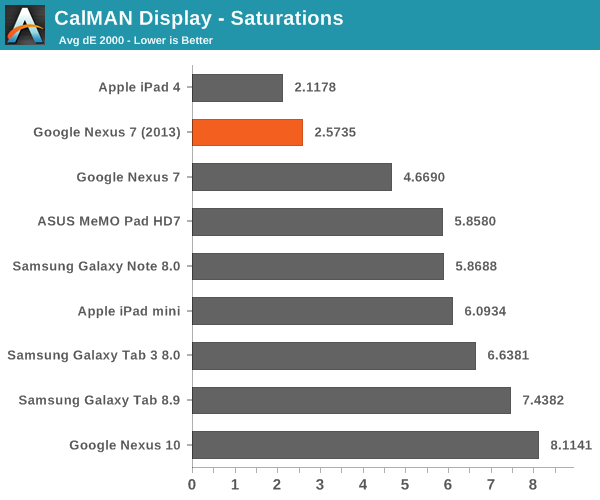
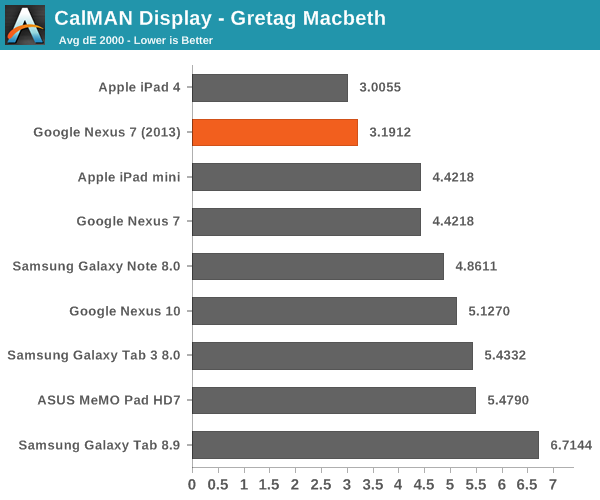
The new panel is also incredibly bright. I typically view 500 nits as the threshold for outdoor usability, and the new Nexus 7 definitely exceeds that threshold. The tablet will drink away all of your battery life if you leave it at this brightness setting indefinitely, but if you need to actually use your tablet outdoors for a while the Nexus 7 works.

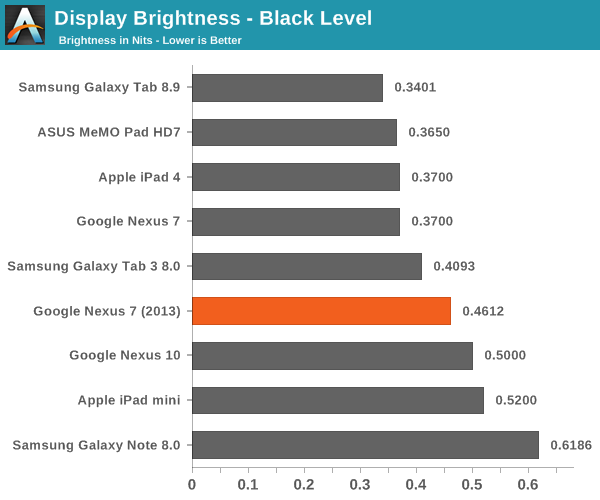
Black levels are a bit higher than on the original Nexus 7, but the resulting peak contrast ratio is still excellent:
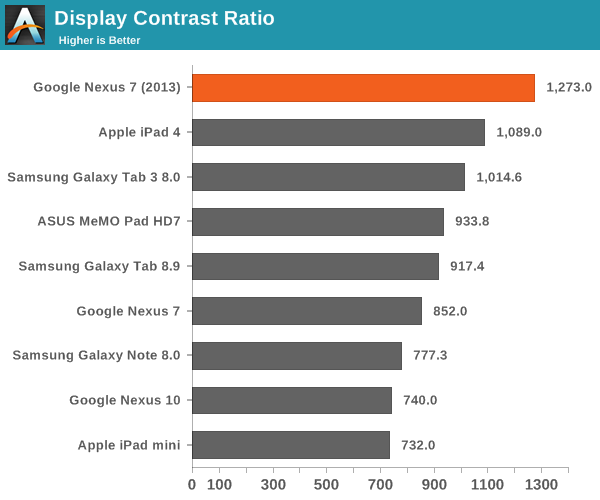
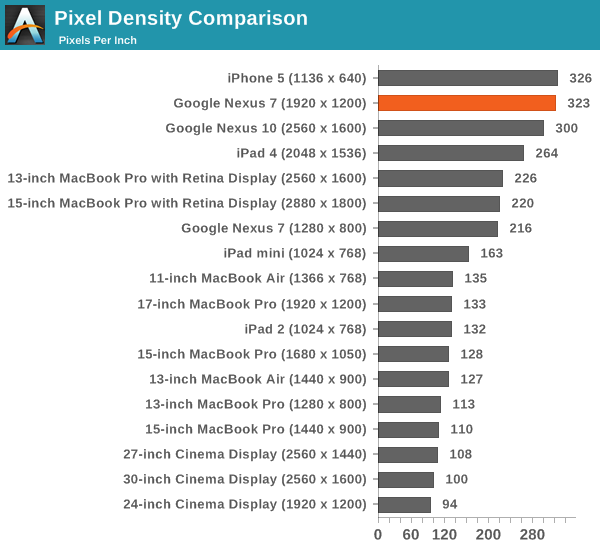
Pixel density shoots through the roof with the new Nexus 7 display as well. Brian was quick to point out that a major advantage of the Android platform is in its flexible resolution handling. The 1920 x 1200 panel presents itself as a 960 x 600 panel to web pages in Chrome, while other apps can use every last pixel for unique content (e.g. games).
The beauty of not having to double the original Nexus 7's resolution but instead settling on an in-between option like 1920 x 1200 is that Google could get away with a performance mainstream SoC instead of something ridiculously high-end.
The display looks great when viewing everything from photos and movies to web pages and eBooks. My only complaint about the Nexus 7's display is its size. A 7-inch tablet is almost pocketable (in fact I did carry it around in my pocket for a day), but the screen can feel a little cramped.


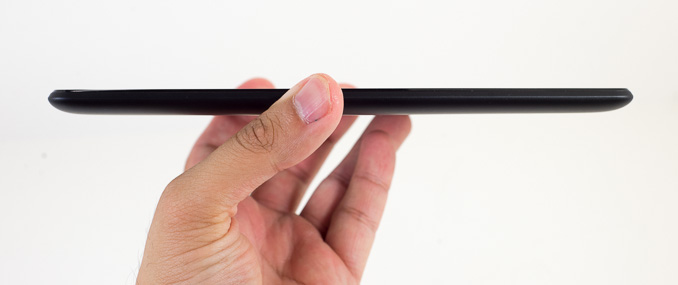
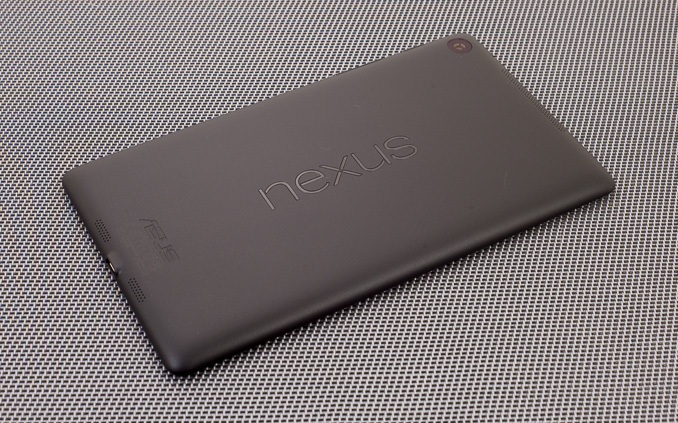
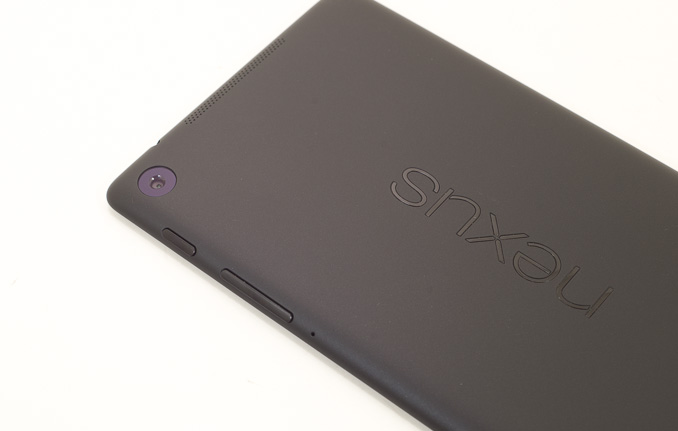


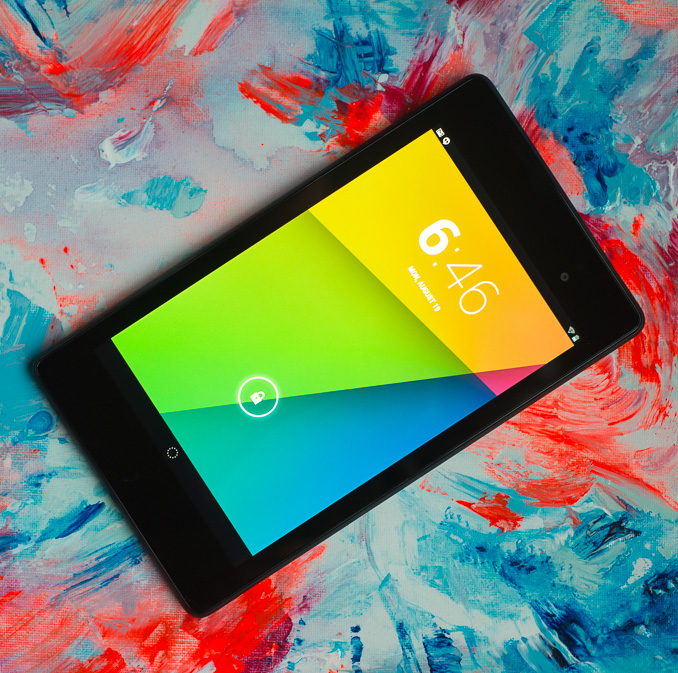
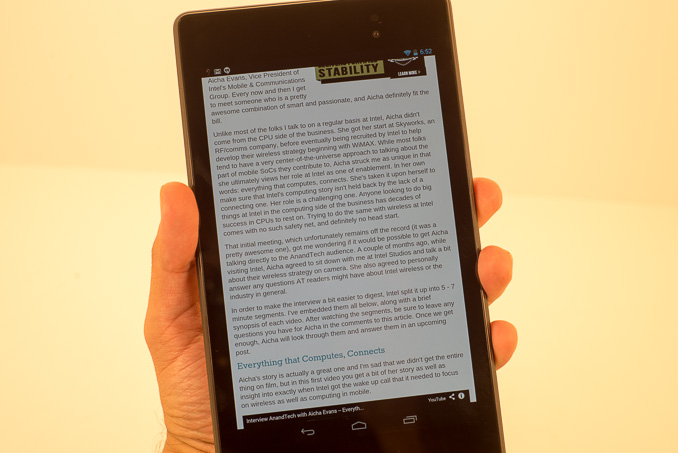
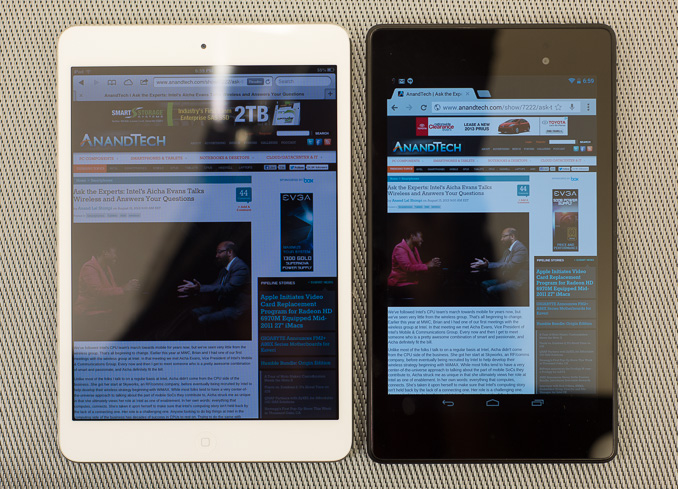








202 Comments
View All Comments
solipsism - Thursday, August 22, 2013 - link
With the Amazon Kindle Fire having the same size display, aspect ratio, running Android (even if it is a more limited version of it), and being at the same $199 price point I wonder why the Kindle Fire isn't compared directly with the Nexus 7.jeffkibuule - Thursday, August 22, 2013 - link
Because it's a more limited version of Android, and software really is everything. Unless you are really into Amazon's ecosystem or just absolutely love hacking software onto hardware, the Kindle Fire isn't a device that should be recommended over the Nexus 7 (2013).hugh2323 - Thursday, August 22, 2013 - link
Have you even used a Kindle Fire? They are so locked into Amazon they are useless as a general purpose tablet. And hacking them is not easy, if possible at all with newer models.BigLan - Thursday, August 22, 2013 - link
I've had the GPS problem on 2 units now - took the first one back which wouldn't last more than 5 minutes without loosing a lock.I've avoided using the google maps/nav app which seems to have worked. I had one gps drop for the first 2 weeks (after copilot crashed) but after update Maps the other day the issues started up again. I uninstalled the update and disabled Maps and it seems to be working again.
I know this is just an anecdote, but maybe it'll work for someone else.
BigLan - Thursday, August 22, 2013 - link
I think that's because Anand is one of the few sites that test at a standard brightness. Most of the other reviews will just use a standard % like 50% which on the new N7 is the same as running the 2012 model at 90% brighness.I haven't seen battery life as long as Anand's numbers though, even using auto brightness which seems like 30-50%, but I do use the gps and play some games which will impact battery life.
It'd be nice to see an idle battery life test as I've seen people complaining about the device losing 10% of the charge daily when unplugged. I know that's be harder (and take much longer) to test, but I've noticed that my adroid devices do drain faster than ios ones do.
teiglin - Thursday, August 22, 2013 - link
You don't need to remind Anandtech readers why brightness-calibrated battery tests are the only reasonable way to test battery life. Percentage tests crack me up every time I see them.I'd also be interested in seeing some sort of idle test, but the things that cause battery to drain while in "standby" are very hard to pin down. Fully power-gated current draw is going to be basically zero for any modern SoC, so that's not really at issue--what causes idle drain is things that wake the device, but usage varies so much that you could argue the issue is not testable--most people probably use push email, so how many emails do you get in a day? Some people may only get half a dozen, while others get hundreds or even more. Do you use Google Now and its location-seeking wakes? Do you let your social networking clients check all the time (some default to ridiculous levels like automatically checking every 15 minutes)?
That doesn't even take into account smaller concerns like signal strength and bluetooth devices--my thoroughly unscientific testing puts the former at around a 1%/hr swing on my phone, while the latter can drain nearly 2%/hr despite being in deep sleep the whole time. I consider "good" idle drain on my phone to be under 1%/hr, though realistically I'm usually a bit higher than that.
That's not to say the issue isn't worth investigating--I'd love to see testing using Brian's base station emulator, and a regular interval for waking with fixed workload at each wake--say, wake every 10 minutes, scan wifi/cellular for location, and receive 1MB of data, or something--but the fact remains that individual circumstances are going to be the absolutely dominant factor in any idle scenario.
As a final note to your iOS comparison, iOS obviously has the advantage of tight controls over how apps can wake the device, so most people will have fewer issues with rogue apps causing high idle drain. Combined with the lack of aggressive Google Now location services, it's not hard to see why iOS tends to do better on battery than Android.
jeffkibuule - Thursday, August 22, 2013 - link
Brian Klug recently stated that an app like Reddit HD, a very popular Reddit client on Android, mindlessly checks for new messages every 15 minutes. That's incredibly wasteful and one of several reasons why Android battery life numbers can easily be all over the place depending on what you have installed.teiglin - Thursday, August 22, 2013 - link
Exactly, dumb apps like that are why the plebs think android has bad battery life. It's unhelpful to said plebs to say "it's not Android's fault" since it is, as far as they know/care, but imo, if you have standby time issues but can't/won't use BetterBatteryStats or similar to determine why, then you're probably better off getting an iPhone (or Windows Phone, if that's your cup of tea).Impulses - Friday, August 23, 2013 - link
That's totally accurate and yet a lot of people would take offense at it... Android gives you a bit more freedom, which is great for some, but it's just more rope to hang yourself with for others. I think both OS approaches have plenty of merit in this world.sprockkets - Thursday, August 22, 2013 - link
ever going to review the nexus 10?